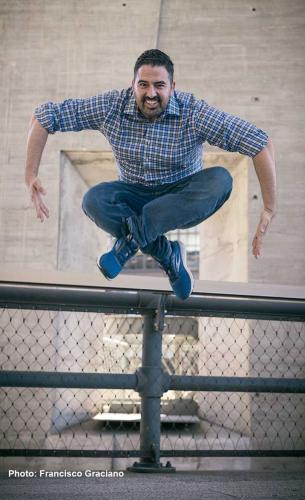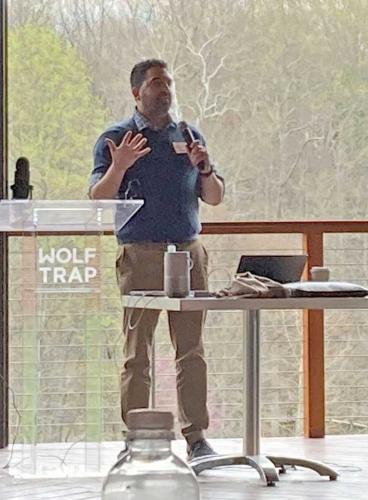
Dance alumnus Gregory Youdan Jr. found his purpose on the stage. Twice.
For a decade after his graduation, he performed with some of New York City’s top dance companies, including Heidi Latsky Dance (HLD), the city’s largest physically integrated, contemporary dance company, which uses performers with and without disabilities and other unique attributes to create provocative, diverse dance pieces.

Dancing with HLD sparked an interest in the biomechanics of dance, which led him from the stage to science. Today, he is a scientist of human movement with two master’s degrees from Columbia University, dedicated to studying dance and the way it can help with neurodegenerative disorders like Parkinson’s and Huntington’s Disease.
Performing with HLD “really started to influence my thinking and my dancing and my work,” Youdan said. “I began teaching Pilates and often worked with clients who wanted to move better or had disabilities. I was intrigued by the idea of researching human movement. It seemed like a natural progression to the work I was already doing.”

A class of 2007 alum, Youdan grew up in Rochester, NY, and began dancing at the age of 9. He had been a child actor, and dancing skills became a necessity if he wanted to continue performing. “I ended up finding a home in dance, and my passion for it only grew as I got older,” he said. “When I was applying to universities, I was looking specifically for schools where I could major in dance.”
His first visit to the university included a ballet class with the then-director of the dance program, Lance Westergard, and a tour of the dorm room of fellow dance major Natalie Tursi ’06, with whom he struck up an immediate friendship.
“Hofstra felt like a place of belonging,” he said.
“All of the faculty were mentors. I feel especially lucky to have worked with Stormy Brandenberger on my independent study project, which evolved into What Remains."
Once settled into his studies at Hofstra, Youdan thrived. Highlights of his time include participating in the American Dance College Dance Association Festival (ACDA) during his senior year. His original work, What Remains, which he choreographed and performed with five classmates, received a standing ovation by the judging panel. Youdan credits his professors for building his talent and confidence as a student and performer.
“All of the faculty were mentors,” he says. “I feel especially lucky to have worked with Stormy Brandenberger on my independent study project, which evolved into What Remains. I studied baroque dance with Rachel List, who is now the chair of the department. After I graduated, Rachel and I performed together as part of the New York Baroque Dance Co. My classes with Dyane Harvey-Salaam inspired me to become certified in Pilates and work as an instructor. I also had my introduction to motor imagery and kinesiology [the mechanics of human movement] with Professor Anita Feldman, and what I learned from her is a big part of what I’m doing today.”
After Hofstra, Youdan spent seven years as a dancer with Heidi Latsky Dance, where he is now a board member.
It was during that time that he learned about the Movement Science and Education program at Teacher’s College and eventually enrolled.
While he was at Teacher’s College, Youdan worked at its Center for Cerebral Palsy Research and as the lab manager of the Neurorehabilitation Research Laboratory. He was also presented with a Wertheimer Fellowship to work with the Mark Morris Dance Center in Brooklyn whose Dance for PD program offers dance classes for people with Parkinson’s disease. Youdan teaches classes online, in-person, and in Spanish.
Youdan explains that dance is like a “hyperdose” of movement, cognitive and behavioral therapeutic interventions available to people with neurological disorders. “Scientifically there are studies about the benefits of dance for people with Parkinson’s,” he says. “Some of the benefits they may see included increased step length, increased walking speed and improved coordination and balance. In a dance class you are thinking. You are problem solving. You are timing your movement to music. And there are social benefits: decreased depression and loneliness.”
After completing a visiting research scholar position at Brown University earlier this summer, Youdan started a dance anatomy teaching fellowship at The Juilliard School, where he is working under the supervision of Irene Dowd, whose book on kinesiology, Taking Root to Fly, was required reading in the Hofstra Dance Program.
Youdan also worked with Hofstra Adjunct Associate Professor of Dance Amy Marshall in the spring on a strength and conditioning pilot study for dancers using current Hofstra dance students.

Youdan presenting on dance for people with Huntington’s Disease at the 2022 International Workshop on the Neural and Social Bases of Creative Movement. Photo: Heidi Latsky.
Youdan wants current Hofstra dance students to know that they are part of a community that is much bigger than the stage. “Just because you earn a dance degree doesn’t mean you have to be a performer,” he says. “There are so many different ways to work within the dance sector. To be honest, I don’t know that I was aware of them all at the time I was an undergrad.”
The person who may be the most surprised that Youdan traded a life of performing for research is Youdan himself. “I was lucky to have my time on the stage, and I would not give that up for anything. But what I’m doing now is equally fulfilling,” he says. “There are subfields within subfields looking at the health benefits for dance. I never imagined I would be at the forefront of that world, but looking back on it now I can see it evolved from what I was doing and learning at Hofstra.”

